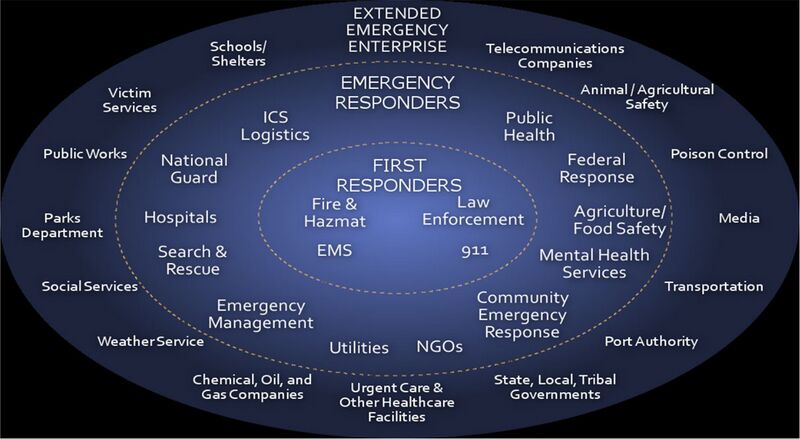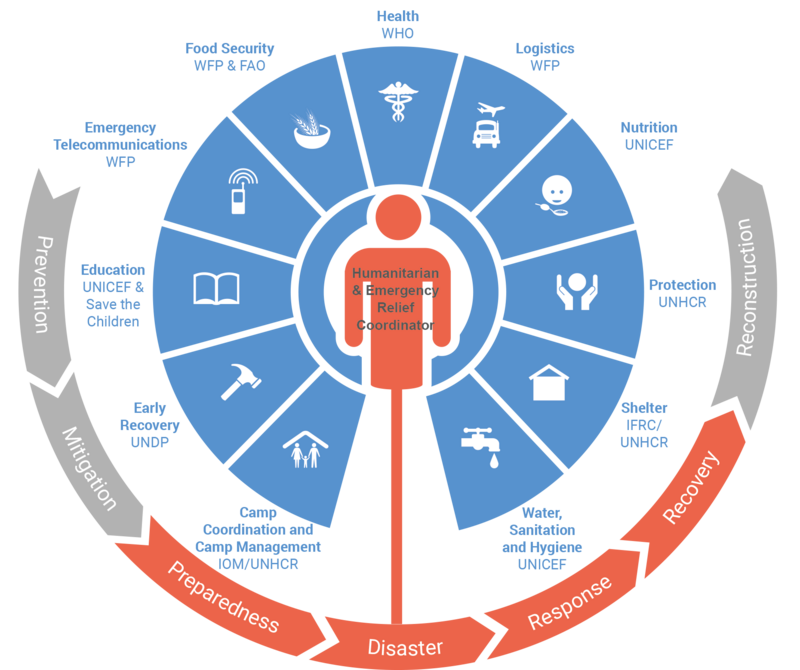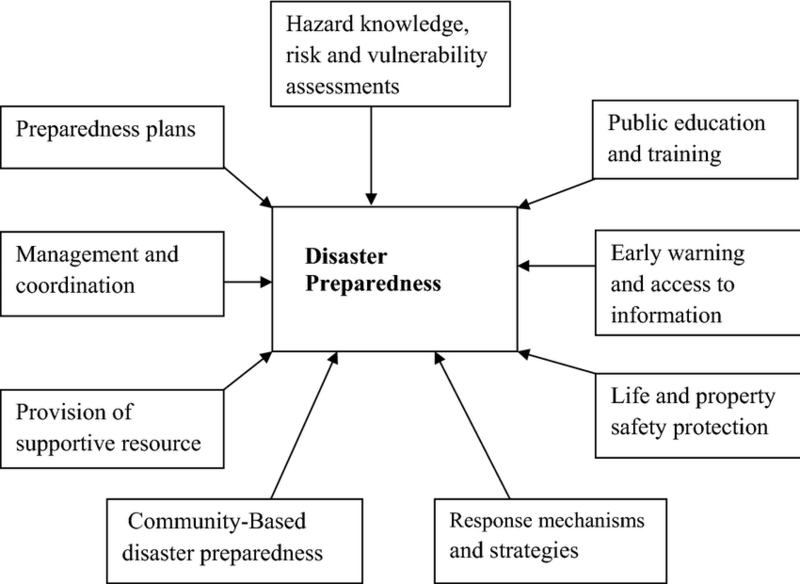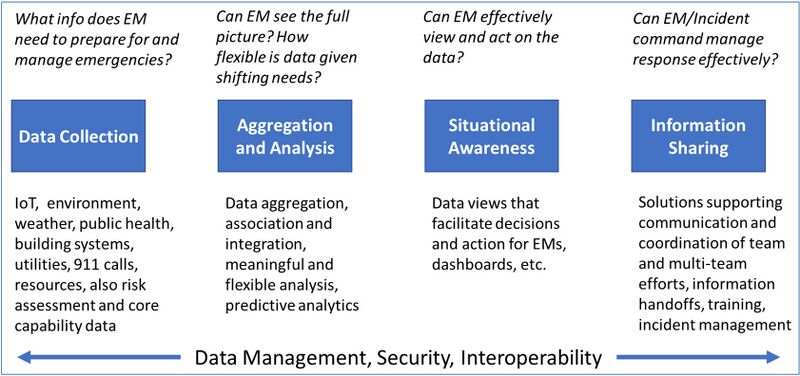Emergency Preparedness: Difference between revisions
No edit summary |
No edit summary |
||
| Line 228: | Line 228: | ||
*'''Refinement''' – Advances the generated prototype through establishing contextual relevance and usability via lab and field testing of the prototype, progressively refining and evolving the innovation, and establishing and expanding targeted metrics and measures to better determine return on investment or impact. | *'''Refinement''' – Advances the generated prototype through establishing contextual relevance and usability via lab and field testing of the prototype, progressively refining and evolving the innovation, and establishing and expanding targeted metrics and measures to better determine return on investment or impact. | ||
*'''Solution''' – Incorporates methods to monitor and report out the initial design strategy as well as impact for learning about how the smart city solution was adopted, adapted, and integrated throughout the system. This phase can define incentives for use and impact on citizen’s lives as well as provide impetus for empirical investigation of the use, impact, and scaling of the innovation. | *'''Solution''' – Incorporates methods to monitor and report out the initial design strategy as well as impact for learning about how the smart city solution was adopted, adapted, and integrated throughout the system. This phase can define incentives for use and impact on citizen’s lives as well as provide impetus for empirical investigation of the use, impact, and scaling of the innovation. | ||
<div id="misc-news" class="mainpage_row"> | |||
<div class="mainpage_box"> | |||
<h3><span class="header_icon" aria-hidden="true" role="presentation"></span><span> Case Study: Multiteam Interaction and Training of City-Wide Emergency Management</span></h3> | |||
<div id=mainpage-help-contribute" title=" Case Study: Multiteam Interaction and Training of City-Wide Emergency Management" class="items"> | |||
Identified Gap and Solution: In a city-based emergency or disaster, multiple teams—including emergency | |||
operations, FEMA, Department of Homeland Security, law enforcement, EMS, fire and rescue, and hospital | |||
trauma teams—must work together in a coordinated response. However, these teams rarely train together. | |||
Key to designing an effective multiteam smart IoT solution is understanding the impact of cross-team | |||
interaction and learning from team members’ real-world interactions as part of a larger city-wide system. | |||
To address this gap, Smart Emergency Medical Team Training developed an IoT system to improve the capture, | |||
analysis, and visualization of mobile behavioral data from proximity sensors worn by individual team members | |||
engaged in a multi-team, live simulation context. The objective was to identify and uncover important | |||
individual, team, and cross-team behavioral data and patterns (e.g. response time, proximity to the patient | |||
and, activity of individuals, teams, and representative of the overall multiteam system, etc.) to improve | |||
experiential learning during the debrief from cross-team interaction in high fidelity simulation training. The goal | |||
is to improve patient care, cross-team coordination and city services teams’ response time. | |||
The Iterative user experience (UX) design and research process included: | |||
*'''Research.''' Through a multiteam training effort focused on extracting, treating and transporting a patient quickly to the hospital emergency room, the research team closely examined, generated, and evaluated best practices in emergency management, response, and healthcare disciplines to understand the context and problems through the users’ experience. From this analysis, prototyped IoT solutions were developed. An agile, flexible UX design process was leveraged aligning with the city’s core capabilities and risk assessments. | |||
*'''Analysis.''' Researchers conducted multiple, detailed investigations and observations of relevant user work processes in live simulations within and across teams to determine target audience(s), system requirements and to model usage, tasks and information flow. These provided the basis for user requirements for the system. | |||
*'''Ideation.''' The refined design goal, drawn from data analysis and generated design models, was directed at improving coordination, situational awareness, learning and performance of the multiteam system. The process strives to uncover the system requirements to iteratively design a system to meet team members’ work goals. In the use case, iterative design cycles continued in the development and integration of existing sensors and custom information systems toward the goal of visualized heterogeneous data sources (e.g. biometric body worn sensors, proximity beacons, 911 dispatch, GPS, GIS, and social media digital data) to provide information on inflection points between the teams—for example, when the patient is handed off from the EMS to the hospital trauma bay team. | |||
*'''Refinement.''' Refining the prototype represents the hard work of bringing an idea to life, progressively testing it through solicitation of targeted feedback and continually improving it through 1) progressive prototyping, 2) deploying, testing and evaluating the system and 3) adopting participatory design. | |||
*'''Solutions.''' The solution generated through a UX design and research process joins end user experience and knowledge with a design and prototype based on rich data from the context of use. The solution has improved ecological validity and is tested in context, thus demonstrating improved opportunities to transition and scale into other environments. While still in development, the project’s iterative prototyping with a participatory design process has garnered interest from other cities and expanded in scope. Deploying an early IoT solution prototype with iterative cycles of improvement permits other cities to consider the adoption, adaptation and diffusion of similar systems in their local contexts as well as provided additional input on the design and use. | |||
</div> | |||
</div> | |||
</div> | |||
Revision as of 21:34, January 3, 2022
| Public Safety | ||||||||||||||||||||||||||
|---|---|---|---|---|---|---|---|---|---|---|---|---|---|---|---|---|---|---|---|---|---|---|---|---|---|---|

| ||||||||||||||||||||||||||
| Sectors | Public Safety | |||||||||||||||||||||||||
| Contact | Brenda Bannan | |||||||||||||||||||||||||
| Topics | ||||||||||||||||||||||||||
Activities
| ||||||||||||||||||||||||||
- Authors
{{{summary}}}
This section addresses the integration of traditional public safety and response into the broader scope of overall community preparedness, planning, and response. It deals with the development and coordination of multi-team systems of emergency response agencies with supporting and secondary organizations that interface directly with front-line responders during a disaster or civil emergency. Collectively, these organizations occupy the inner and second circles of Figure 2, and constitute the combined response capability of a community, jurisdiction, or region , and may be augmented by additional resources deployed through Emergency Management Assistance Compacts (EMAC) with adjacent states or jurisdictions or from federal sources, such as FEMA and other agencies.

For technology solution providers, this section provides insight into EM workflows and decision-making priorities. Industry may better address EM needs by understanding the concepts, frameworks, and language EMs use. Technology solutions should address identified gaps in a way EMs understand and manage crises and disaster operations. Therefore, this section begins with an overview of emergency management models and best practices that will inform development of a shared language for identifying and articulating fundamental EM requirements.
For EMs, this section provides insight into the relevant data, tools, and technology solutions available to meet their needs and ways to effectively evaluate and integrate technologies and associated protocols. Goals include:
- Improve EMs’ ability to evaluate and integrate S&CC/IoT technology into their emergency preparedness, management, and response processes—both for day-to-day operations (Blue-Sky days) and large-scale emergencies impacting multiple systems (Gray-Sky days).
- Enable technology solution providers to better understand and address EM needs through meaningful use cases by presenting EM frameworks and language.
- Suggest a collaborative, participatory process for design and integration of IoT solutions involving emergency management professionals, IT solution providers, and the community.
- Provide examples of how existing IoT technologies can help provide solutions to city challenges.
- Identify new vulnerabilities created by the connectedness of the previously unconnected first responder teams.
Key Characteristics
In general, the whole-of-community approach begins to have impact with emergency preparedness and management, where benefits from new technologies and the integration via advanced wireless networks supporting deployed sensors is most easily achieved. For preparedness, dual -use or multi-purpose technologies with utility in both Blue-Sky and Dark-Sky scenarios can achieve the greatest cost- effectiveness and potential for rapid adoption.
Key characteristics of the emergency preparedness and management approach to smart technology solutions include:
- More diverse opportunities for identifying and defining requirements to improve public safety (i.e., a bigger marketplace) and higher likelihood that technologies can be adopted without disrupting operational readiness of critical agencies and community functions;
• Connection with critical infrastructure systems already undergoing fundamental technology upgrades and transitions, including the adoption of high-speed wireless networks, embedded IoT sensors, data-mining and social networking platforms, resilient electrical grids, and general access to commercial enterprises that support these systems; • Close relationship with both commercial and public research and development institutes, and a willingness to accept a certain amount of risk in technology investment; and, • Risk of developing or adopting systems incompatible with current systems used by first responders and agencies, or that require fundamental changes in operating doctrine or procedures among those agencies. Integrating S&CC and IoT technologies into the emergency preparedness process brings opportunities (such as better situational awareness) as well as complexities (such as increased volume and variety of data) for emergency managers. As communities adopt smart technologies, they must rethink policies, operating procedures, and interagency planning and communications for all phases of emergency management to fully leverage new opportunities. Similarly, while the S&CC/IoT technical community has made significant advances in developing technology solutions, they must incorporate input and context- specific validation from emergency managers (EMs) and related personnel to fully meet user needs.
Emergency Preparedness Models and Best Practices
Two current models serve as sound examples of operational systems for organizing emergency management and response structures: the U.S. National Response Framework and National Preparedness System, and the international Cluster System adopted by the United Nations. Both represent best practice foundations and a shared language for identifying and assessing emergency management needs, and may be adapted for use in S&CC for potential IoT integration and innovation. Successful smart technology solutions will address specific needs jurisdictions may have within these frameworks. In either case, similarity with existing operationally tested frameworks is a virtue and should be pursued in U.S. and international applications within S&CC to the extent feasible.
U.S. Model
The U.S. National Response Framework/National Preparedness System (NRF/NPS) model establishes a single, comprehensive approach to incident management within the U.S. The NRF is used to achieve the National Preparedness Goal of a secure and resilient nation with the capabilities required across the whole community to prevent, prepare for, respond to, and recover from terrorist attacks, major disasters, and other emergencies. The NPS preparedness cycle comprises the five key phases or mission areas of emergency preparedness and response: prevention, mitigation, response, recovery and protection. Within these phases are identified analysis and assessment actions include:
- Threat and Hazard Identification and Risk Assessment (THIRA) – A four step common risk assessment process that helps a community develop a comprehensive hazard catalogue for threats and hazards of greatest concern, community defined desired outcomes, risk overview with hazard profiles and estimated impacts, and capability targets. There are 24 risk categories.
- Core Capabilities Analysis – Communities engage in gap analysis planning efforts with capabilities falling into mission areas. As gaps are identified, specific needs emerge. Technology plays a role in helping EMs address these gaps within a core capability and across capabilities and in performing consequence analysis.
Technology solutions and innovations may enhance risk assessment through data collection and aggregation, modeling, predictive analysis, and dashboard views. Figure 6 shows the 32 core capabilities as they relate to the five mission areas of the NRF cycle. Hazard analysis is key to overall preparedness goals; planning and public information and warning are associated with all phases.

International Models
When a large-scale emergency occurs, the capacity of a city, state or national emergency management infrastructure may be insufficient to handle the response alone. Therefore, in the international space, when multiple organizations respond, effective coordination among response stakeholders is essential for meaningful emergency management. Good coordination stems from effectively involving multiple teams and stakeholders and minimizing gaps and duplications in the response work across organizations. However, the need of inter-agency coordination expands to all phases of the crisis management from prevention to reconstruction and it is the core of large-scale emergency preparedness. To address this complexity of coordination across the diversity of organizations involved (e.g., governmental vs. non-governmental vs. voluntary), the domain expertise and skills required, and the varied tasks, United Nations has proposed a Cluster System11 as shown in Figure 7.

According to the United Nations Inter-Agency Standing Committee (IASC), the primary goal of this Cluster Approach is to strengthen system-wide preparedness and technical capacity to respond to large events or emergencies and to provide clear leadership and accountability in the main areas of emergency and humanitarian crisis response. At the nation level, it helps strengthen partnerships such as with the NRF in the U.S; and the predictability and accountability of international humanitarian action can be better understood with its help. By improving prioritization and clearly defining the roles and responsibilities of humanitarian organizations, the Cluster Approach has common features and synergies to NRF and NPS. The IASC guidelines and the UN Office of Coordination for Humanitarian Affairs emphasize:
- Supporting service delivery by providing a platform for agreement on approaches and elimination of duplication;
- Informing strategic decision-making for the humanitarian response through coordination of needs assessment, gap analysis and prioritization;
- Planning and strategy development including sectoral plans, adherence to standards and funding needs;
- Advocacy to address identified concerns on behalf of cluster participants and the affected population;
- Monitoring and reporting on the cluster strategy and results; recommending corrective action where necessary; and,
- Contingency planning/preparedness/national capacity building where needed and where capacity exists within the cluster.
The Cluster Approach objectives are like those of the NRF. In addition, in the international disaster response practice, the International Federation of Red Cross and Red Crescent (IFRC) Societies identifies the following elements in its comprehensive disaster preparedness strategic practices which can be adopted in a proposed model for defining preparedness requirements in a smart city context (Figure 8).

City Emergency Management Needs and Resources
As emergency managers plan for and respond to emergencies, they see the need for smart technology solutions to support all phases of the NPS preparedness cycle or international preparedness models. To provide effective smart solutions for emergency management, technologists must understand EMs’ values, priorities, processes, goals, and specific requirements that support them, as well as the broader ecosystem of resources available. EM goals may include: reducing overall risk, knowing hazard asset impacts, automating awareness, and so on. For example, emergency preparedness and management involves coordinating information and professionals in a multi-team response with complex interdependencies of communication. resource sharing, and allocations to address any significant emergency such as an active shooter, terrorist attack, high-rise fire, and so on. The required multi-agency response demands enhanced situation awareness, judgment, and decision-making—providing an opportunity for IoT technologies to infor m emergency managers through real-time data collection and visualization as well as other potential capabilities. While all jurisdictions prepare for emergencies, the level of smart technology integration in this process depends on available resources, funding, experience, threats confronted, and other factors unique to each community.
Requirements
Participants in the March 2017 PSSC Workshop identified the following key requirements for technology solutions for emergency management and preparedness:
- Shared Situational Awareness: The need for common platforms and operating procedures for all entities that share information and participate in emergency decision-making.
- Governance: The need for a governance structure that defines smart city/IoT processes from procurement through implementation and ensures accountable oversight.
- Collaboration: The need to bridge the gap between technologists and public safety personnel—finding a shared language based on a clear understanding of requirements and priorities.
- Data: The need for planners to access the right data and make it actionable for emergency management and response.
- Adaptation: The need to map solutions to existing emergency management frameworks and systems, rather than use “one-off” solutions, and to adapt to change.
- Planning: The need to scale response capabilities to meet emergencies—technology can enable broader adoption. Scalability for scope and price in smaller jurisdictions is critical for broader adoption and longer-term commercialization of technologies.
Participants also identified technology design, development, and integration processes to address emergency management needs for:
- Modeling and simulation:
- Models for standardizing risk assessments and planning to:
- Understand gaps in capabilities and resources against potential threats
- Identify and prioritize threats and assess risk
- Identify and link pre-assessment interdependencies
- Resilience mapping, gross modeling, and simulation tools
- Models for standardizing risk assessments and planning to:
- Communications: Robust and interoperable systems and data that can lead to informed action, along with more human expertise across systems.
- Information sharing: Full-scale situational awareness capable of integrating data from a broad range of systems, including open data, city-owned IoT, smart buildings, environmental sensors, and other sources.
- Participatory, collaborative design, and innovation: involving all stakeholders and community members in design, development and integration of IoT technologies for emergency management.
Resources
PSSC Workshop participants identified the following resources that EMs utilize for preparedness. Technology solutions can also strengthen the management and integration of these resources and their accessibility to emergency managers.
- Planning Models and Capabilities
- Interoperable models and decision tools to enable:
- Regional, national and international planning and risk assessment
- Supply chain and logistics management
- Management of communications resources
- Post-disaster community recovery
- Interoperable models and decision tools to enable:
- Partnership Models
- Mutual aid relationships
- Integration of citizen resources, such as Citizen Corps Councils, Community Emergency
Response Teams, Medical Reserve Corps, Fire Corps, and Neighborhood Watch
- Personnel and Facilities
- Local and regional government-owned infrastructure
- Privately owned infrastructure (telecommunications; transportation, etc.)
- Business, financial and economic resources
- Governance, community anchors, social services, and leadership
Adopting Technology Solutions to Address Emergency Management Needs
Priorities for technology solutions are focused on improving coordination among multi-team systems of responders; the integration of both public and private data and information into emergency preparedness practices (such as access and portability of critical medical data among patient populations), and similar challenges that have legal, proprietary, and security barriers, as well as policy implications. Technology Requirements Development Process
As smart technologies expand the range of available data for EMs to make better planning and response decisions, solutions must meet EM requirements for how that data will be synthesized and used. Can EMs apply data within various forecasting models based on specific situations? Can they integrate different elements and run predictive analyses? Is the data presented in a way that EMs and incident command can effectively use? Do solutions enhance the effectiveness of intra- and inter-team communications and response?
An important objective is helping technology pr oviders fully understand the complexity of emergency response and the ecosystem of people, organizations, and resources involved so they can effectively address these demanding situations with technology applications and IoT innovations. Involving stakeholders in identifying problems and generating ideas, and enabling technology developers to immerse themselves in EM roles, context, and workflow is critical to meeting EM needs with targeted solutions. To articulate a broad process model that may consider local needs for emergency management, we must first consider the EM’s role and actions in identifying specific information needs and data management for effective visualization and response (see Figure 9).

In this model, data management, security, interoperability, and other requirements such as reliability, scalability, and availability are required throughout the ecosystem. Solution features such as plug and play, multiple use, and ease of use are critical to acceptance.
Technologies should:
- Draw upon data that can be acted on for emergency planning and response.
- Improve the handoff of information across systems – including addressing handoff issues through simulation, training, and modeling.
- Be based on open standards that enable interoperability for device interchangeability and data sharing.
- Leverage non-government resources (e.g., business/community/region) and mutual aid (e.g., human and material resources).
- Leverage dual or multi-use technologies where possible for improving ROI (for more information, see the later section on “Seeking Co-Benefits with Dual-Use Technologies.”
- Provide user experience that meets specific public safety requirements in a range of environments and use scenarios.
- Provide adequate training to optimize use and applicability in a wide range of scenarios.
Aligning Technology Efforts with City Needs To ensure technology efforts align with city needs, technology solution providers should work with stakeholders to:
- Identify the problem to be solved within a recognized emergency management model, such as NRF, considering direct and secondary consequences of an emergency (for example, a water system failure impacts ability to fight fires) and the scope across phases from planning through recovery.
- Analyze available data and identify gaps in understanding or response. This may include an assessment of hazards, consequence, cross agency needs/assets analysis, impact analysis, GIS/mapping, and other existing data modeling/analysis.
- Identify specific requirements within core capabilities and gaps across the response spectrum that IoT/smart technology may address. This includes planning and response goals and technology needs analysis.
- Address the problem by repositioning, improving, or integrating existing technologies where feasible or innovating new solutions where necessary.
- Explore multi-use cases for solutions, addressing one or more core capabilities and primary and secondary benefits.
- Identify funding opportunities that can support initial implementation and sustaining operations.
- Build standards-based solutions so that data is interoperable by default.
Applied Research and Development Process
One model technology providers may consider is the applied research and development process for engineering smart city solutions, which incorporates a user-centered or user experience (UX) design and research approach. This is an iterative, progressive, and agile four-phase design process applicable for generating, refining, and scaling emergency management IoT solutions (see Table 1).
- Research and Analysis – Elicits collaborative analysis and city assessment with citizens and stakeholders to establish a common vision for smart city innovation. This UX design process also permits emergency managers to work from established processes and frameworks familiar to them so that technology developers can intersect in this process to target their needs for UX smart city systems.
- Ideation – Establishes a collaborative design process with citizens and stakeholders to elicit multiple perspectives on the problem, generate multiple design ideas, and prioritize and clarify the behavioral or performance targets aligned with meaningful data streams for smart city IoT innovations.
- Refinement – Advances the generated prototype through establishing contextual relevance and usability via lab and field testing of the prototype, progressively refining and evolving the innovation, and establishing and expanding targeted metrics and measures to better determine return on investment or impact.
- Solution – Incorporates methods to monitor and report out the initial design strategy as well as impact for learning about how the smart city solution was adopted, adapted, and integrated throughout the system. This phase can define incentives for use and impact on citizen’s lives as well as provide impetus for empirical investigation of the use, impact, and scaling of the innovation.
Case Study: Multiteam Interaction and Training of City-Wide Emergency Management
Identified Gap and Solution: In a city-based emergency or disaster, multiple teams—including emergency operations, FEMA, Department of Homeland Security, law enforcement, EMS, fire and rescue, and hospital trauma teams—must work together in a coordinated response. However, these teams rarely train together. Key to designing an effective multiteam smart IoT solution is understanding the impact of cross-team interaction and learning from team members’ real-world interactions as part of a larger city-wide system. To address this gap, Smart Emergency Medical Team Training developed an IoT system to improve the capture, analysis, and visualization of mobile behavioral data from proximity sensors worn by individual team members engaged in a multi-team, live simulation context. The objective was to identify and uncover important individual, team, and cross-team behavioral data and patterns (e.g. response time, proximity to the patient and, activity of individuals, teams, and representative of the overall multiteam system, etc.) to improve experiential learning during the debrief from cross-team interaction in high fidelity simulation training. The goal is to improve patient care, cross-team coordination and city services teams’ response time.
The Iterative user experience (UX) design and research process included:
- Research. Through a multiteam training effort focused on extracting, treating and transporting a patient quickly to the hospital emergency room, the research team closely examined, generated, and evaluated best practices in emergency management, response, and healthcare disciplines to understand the context and problems through the users’ experience. From this analysis, prototyped IoT solutions were developed. An agile, flexible UX design process was leveraged aligning with the city’s core capabilities and risk assessments.
- Analysis. Researchers conducted multiple, detailed investigations and observations of relevant user work processes in live simulations within and across teams to determine target audience(s), system requirements and to model usage, tasks and information flow. These provided the basis for user requirements for the system.
- Ideation. The refined design goal, drawn from data analysis and generated design models, was directed at improving coordination, situational awareness, learning and performance of the multiteam system. The process strives to uncover the system requirements to iteratively design a system to meet team members’ work goals. In the use case, iterative design cycles continued in the development and integration of existing sensors and custom information systems toward the goal of visualized heterogeneous data sources (e.g. biometric body worn sensors, proximity beacons, 911 dispatch, GPS, GIS, and social media digital data) to provide information on inflection points between the teams—for example, when the patient is handed off from the EMS to the hospital trauma bay team.
- Refinement. Refining the prototype represents the hard work of bringing an idea to life, progressively testing it through solicitation of targeted feedback and continually improving it through 1) progressive prototyping, 2) deploying, testing and evaluating the system and 3) adopting participatory design.
- Solutions. The solution generated through a UX design and research process joins end user experience and knowledge with a design and prototype based on rich data from the context of use. The solution has improved ecological validity and is tested in context, thus demonstrating improved opportunities to transition and scale into other environments. While still in development, the project’s iterative prototyping with a participatory design process has garnered interest from other cities and expanded in scope. Deploying an early IoT solution prototype with iterative cycles of improvement permits other cities to consider the adoption, adaptation and diffusion of similar systems in their local contexts as well as provided additional input on the design and use.





